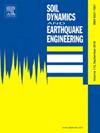基于CPO-VMD-HT和振动台试验边际谱法的路堤边坡地震破坏机理研究
IF 4.2
2区 工程技术
Q1 ENGINEERING, GEOLOGICAL
引用次数: 0
摘要
川藏交通走廊沿线分布着多个潜在震源带,但川藏交通走廊段拉林芝铁路沿线路堤边坡的震害特征和动力破坏机制尚不清楚。将冠猪优化器(CPO)与变分模分解-希尔伯特变换(VMD-HT)相结合,首次建立了地震信号的CPO-VMD-HT算法,提出了一种基于边际谱的震害机理识别方法。通过对典型路堤边坡的大型振动台试验,验证了该方法的有效性。结果表明:路基边坡加速度的放大效应主要由0 ~ 20 Hz地震能量与45 ~ 55 Hz共振能量的相互叠加引起;当地震激发引起边坡共振时,路堤处的加速度放大系数β由2.16减小到1.26。当输入峰值地面加速度(PGA)为0.5 g时,地震能量的第二大取值区域出现在路堤左趾,峰值边际谱幅值(PMSA)达到86.27。第一塑性区和第二塑性区逐渐合并形成滑动面,使路堤边坡进入临界失稳状态。通过对PMSA的分析,可以看出路堤边坡各层间希尔伯特能量分布的差异,阐明了边坡内部剪切带的发育和动力破坏机制。从能量传播的角度出发,阐明了路堤边坡的加速度放大效应和地震破坏机理。对地震易发区铁路边坡的安全风险感知和准确趋势预测具有重要的参考意义。本文章由计算机程序翻译,如有差异,请以英文原文为准。
Seismic failure mechanism investigation of embankment slope based on the CPO-VMD-HT and marginal spectrum method using shaking table test
Several potential seismic source zones are distributed along the Sichuan–Tibet traffic corridor, but the seismic damage characteristics and dynamic failure mechanisms of the embankment slopes along the Lhasa–Nyingchi Railway, a segment of the corridor, remain unclear. By integrating the Crested Porcupine Optimizer (CPO) and Variational Mode Decomposition-Hilbert Transform (VMD-HT), this paper establishes the CPO-VMD-HT algorithm for seismic signals for the first time and puts forward an identification method for the seismic damage mechanism based on the marginal spectrum. The effectiveness of this method is validated through large-scale shaking table experiments conducted on a typical embankment slope. The results demonstrate that the amplification effect of the embankment slope acceleration is mainly triggered by the mutual superposition of the 0–20 Hz seismic energy and the 45–55 Hz resonant energy. When seismic excitation triggers slope resonance, the acceleration amplification coefficient β at the embankment decreases from 2.16 to 1.26. When the input peak ground acceleration (PGA) is 0.5 g, the second highest value area of seismic energy emerges at the left toe of the embankment, with the peak marginal spectrum amplitude (PMSA) reaching 86.27. The first and second plastic zones gradually coalesce and form a sliding surface, driving the embankment slope into the critical state of instability. Through an analysis of the PMSA, differences in the Hilbert energy distribution within various layers of the embankment slope can be discerned, elucidating the development of shear bands and the dynamic failure mechanisms within the slope. Conducted from an energy propagation perspective, this paper clarifies the acceleration amplification effect and seismic failure mechanisms of embankment slopes. It is thus a crucial reference for the safety risk perception and accurate trend prediction of railway slopes in earthquake-prone areas.
求助全文
通过发布文献求助,成功后即可免费获取论文全文。
去求助
来源期刊

Soil Dynamics and Earthquake Engineering
工程技术-地球科学综合
CiteScore
7.50
自引率
15.00%
发文量
446
审稿时长
8 months
期刊介绍:
The journal aims to encourage and enhance the role of mechanics and other disciplines as they relate to earthquake engineering by providing opportunities for the publication of the work of applied mathematicians, engineers and other applied scientists involved in solving problems closely related to the field of earthquake engineering and geotechnical earthquake engineering.
Emphasis is placed on new concepts and techniques, but case histories will also be published if they enhance the presentation and understanding of new technical concepts.
 求助内容:
求助内容: 应助结果提醒方式:
应助结果提醒方式:


